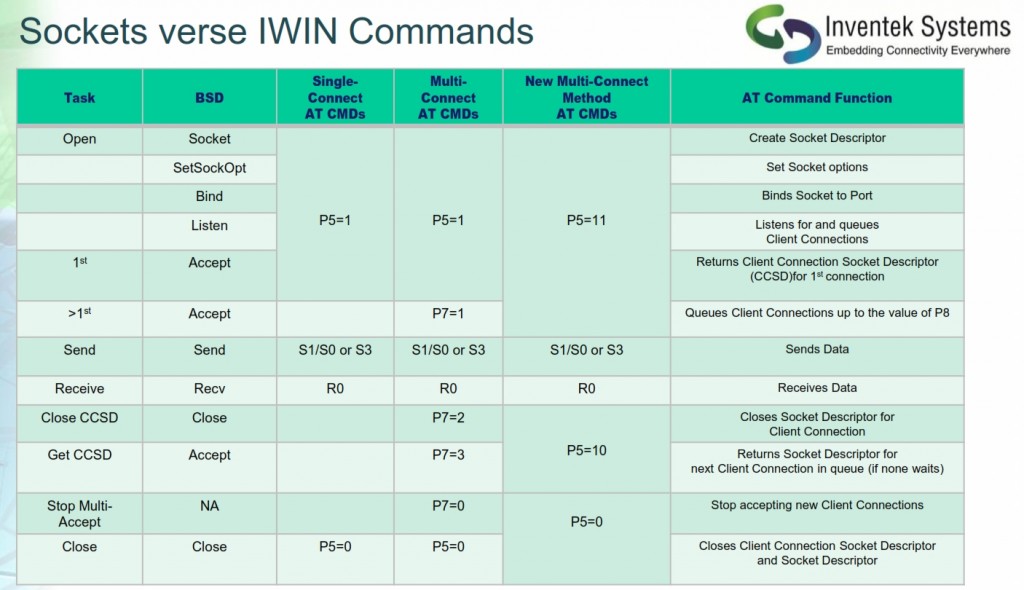BSD Socket FunctionsSocket
- SetSocketOpts
- Bind
- Listen
- Accept
- Send
- Recv
- Connect
- Close
Connection Server Setup
| AT Command | Function |
| P0=<0,1,2,3> | Select Socket |
| P1=<0,1,2,3> | Select Protocol |
| P2=<Port> | Set Port |
| P8=<0-6> | Set Number of Backlogs |
Single Connection Server
| Task | BSD | AT Command | AT Command Function |
| Open | Socket | P5=1 | Create Socket Descriptor |
| SetSockOpt | Set Socket options | ||
| Bind | Binds Socket to Port | ||
| Listen | Listens for and queues Client Connections | ||
| Accept | Returns Socket Descriptor for Client Connection | ||
| Send | Send | S1/S0 or S3 | Sends Data |
| Receive | Recv | R0 | Receives Data |
| Close | Close | P5=0 | Closes Client Connection Socket Descriptor and Socket Descriptor |
Multi-Connection Server – AT Commands
| AT Command | Response | Comments |
| PK=1,3000 | Ok | Starts the TCP keep alive |
| P1=0 | Ok | Sets connection to TCP |
| P2=5024 | Ok | Selects the port ( Note: your firewall may block certain ports. Also, we prefer to use Hercules is you are testing on a PC) |
| P8=6 | Ok | Sets the number of backlog requests |
| P5=11 | [TCP TSK] Multi-Accept Setup[TCP SVR] Waiting on connection …OK | Start Multi-Accept Server. The modules is waiting for a client to connect |
| R0 | Reads data xxxxx ok | R0 = Will read the dataR0= -1 ( This means the connection is lost by either the TCP keep alive or the client) |
| S3=1\r2 | 1ok | S3 will send a 1 and the response will be 1 byte of data sentS3= -1 ( This means the connection is lost by either the TCP keep alive or the client) |
| P5=10 | [TCP SVR] Waiting on connection …> OK | Close and wait for the next connection |
| P5=0 | Ok | This actually closes the socket and connection |
Here is the sequence for using a TCP Multi-accept server. Please remember that TCP is a peer-to-peer connection. This means that only one connection can be handled at a time and once the communication is complete the connection is closed.
Join a network first.
Use P0=0-4 to select socket. If you only have 1 socket you can ignore this command.
>PK=1,3000 // Starts keep alive
>P1=0 //Sets TCP
OK
>P2=5024 //selects port
OK
>P8=6 //Set the number backlog requests (0-6).
OK
>P5=11 //Start Multi-Accept server
[TCP TSK] Multi-Accept Setup
[TCP SVR] Waiting on connection …
OK
[TCP SVR] Accepted 192.168.10.100:34489 //Connection from TCP Client
> R0
Data from 192.168.10.100
OK
> S3=1\r1
1
OK
> P5=10 //Close current and wait for next connection
[TCP SVR] Waiting on connection …
OK
[TCP SVR] Accepted 192.168.10.100:34504 //Connection from TCP Client
> R0
Data from 192.168.10.100
OK
> S3=1\r2
1
OK
> P5=0 //Shutdown server
[TCP TSK] Killed
OK
Please remember when comparing to a Windows server and a internet browser the process
is the same. The browser sends multiple http request and the server handles them sequentially.
